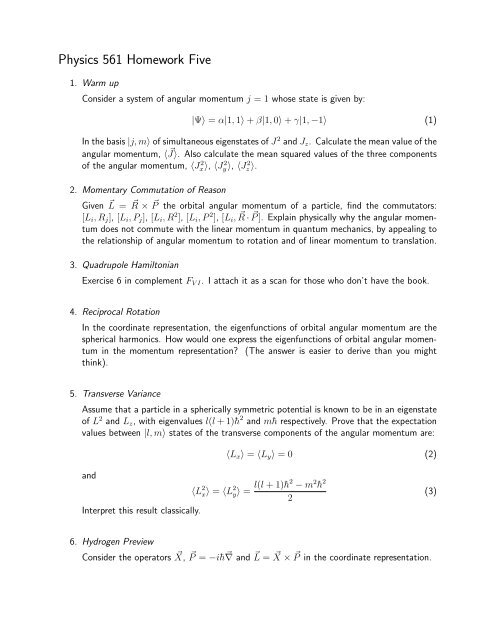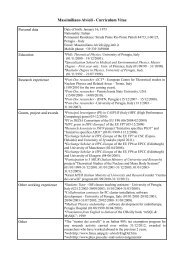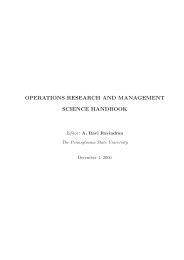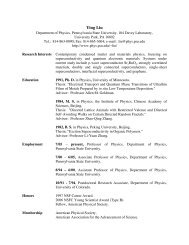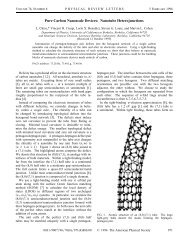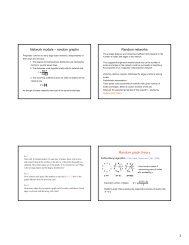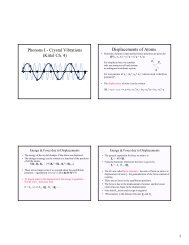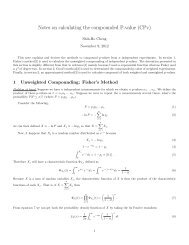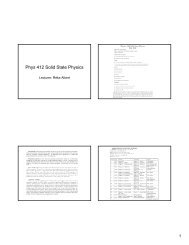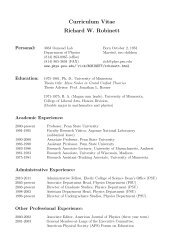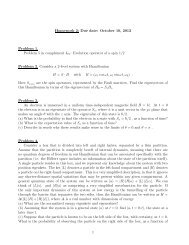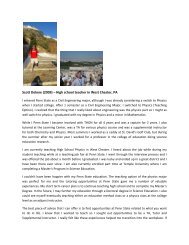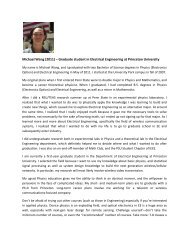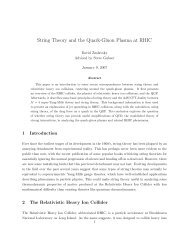Physics 561 Homework Five
Physics 561 Homework Five
Physics 561 Homework Five
You also want an ePaper? Increase the reach of your titles
YUMPU automatically turns print PDFs into web optimized ePapers that Google loves.
<strong>Physics</strong> <strong>561</strong> <strong>Homework</strong> <strong>Five</strong><br />
1. Warm up<br />
Consider a system of angular momentum j = 1 whose state is given by:<br />
|Ψ〉 = α|1, 1〉 + β|1, 0〉 + γ|1, −1〉 (1)<br />
In the basis |j, m〉 of simultaneous eigenstates of J 2 and J z . Calculate the mean value of the<br />
angular momentum, 〈 ⃗ J〉. Also calculate the mean squared values of the three components<br />
of the angular momentum, 〈J 2 x〉, 〈J 2 y 〉, 〈J 2 z 〉.<br />
2. Momentary Commutation of Reason<br />
Given ⃗ L = ⃗ R × ⃗ P the orbital angular momentum of a particle, find the commutators:<br />
[L i , R j ], [L i , P j ], [L i , R 2 ], [L i , P 2 ], [L i , ⃗ R · ⃗P ]. Explain physically why the angular momentum<br />
does not commute with the linear momentum in quantum mechanics, by appealing to<br />
the relationship of angular momentum to rotation and of linear momentum to translation.<br />
3. Quadrupole Hamiltonian<br />
Exercise 6 in complement F V I . I attach it as a scan for those who don’t have the book.<br />
4. Reciprocal Rotation<br />
In the coordinate representation, the eigenfunctions of orbital angular momentum are the<br />
spherical harmonics. How would one express the eigenfunctions of orbital angular momentum<br />
in the momentum representation? (The answer is easier to derive than you might<br />
think).<br />
5. Transverse Variance<br />
Assume that a particle in a spherically symmetric potential is known to be in an eigenstate<br />
of L 2 and L z , with eigenvalues l(l + 1)¯h 2 and m¯h respectively. Prove that the expectation<br />
values between |l, m〉 states of the transverse components of the angular momentum are:<br />
〈L x 〉 = 〈L y 〉 = 0 (2)<br />
and<br />
〈L 2 x〉 = 〈L 2 y〉 = l(l + 1)¯h2 − m 2¯h 2<br />
2<br />
Interpret this result classically.<br />
(3)<br />
6. Hydrogen Preview<br />
Consider the operators ⃗ X, ⃗ P = −i¯h ⃗ ∇ and ⃗ L = ⃗ X × ⃗ P in the coordinate representation.
( ( )<br />
(a) Prove that P 2 = ⃗P · ˆX)<br />
ˆX · P ⃗ − 1 ⃗ ( )<br />
P ·<br />
r<br />
ˆX × L ⃗ where r ˆX = X. ⃗ Be careful of<br />
operator ordering.<br />
(b) Use this result to show that the momemtum squared, which is closely related to the<br />
kinetic energy operator, can be written as a piece that depends only on r plus a piece<br />
that depends on the magnitude of the angular momentum operator:<br />
P 2 = −¯h 2 ( ∂<br />
∂r 2 + 2 r<br />
∂<br />
∂r<br />
)<br />
+ L2<br />
r 2 (4)<br />
This expression can be used to simplify the Schrodinger equation for a particle in a<br />
spherically symmetric potential, such as in the hydrogen atom.


